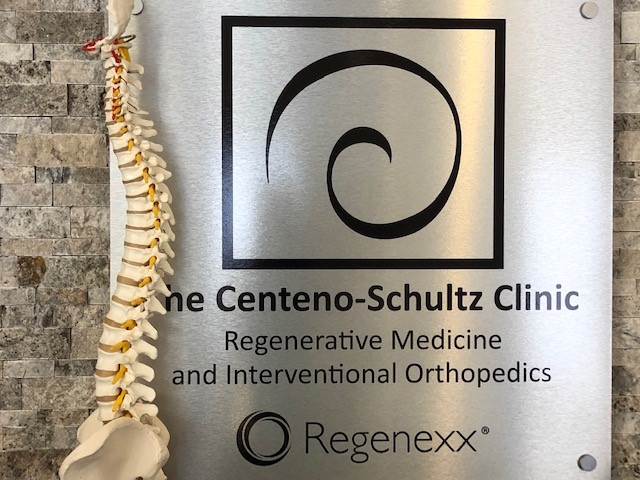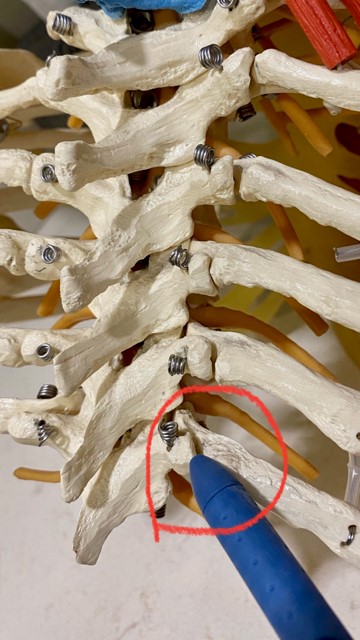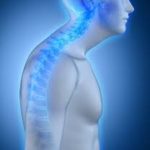Pain can be debilitating and can erode one’s sense of purpose and well-being. Unfortunately, compared to the neck and low back, thoracic spine pain has received little attention. Why?
It is a complex area that has many moving parts which are discussed below. Thoracic injections have potentially significant complications given the close proximity of the nerves, blood vessels, and lungs. A needle that is advanced too deep or too lateral to the targeted thoracic structure can potentially puncture the lung causing a collapse of the lung also known as pneumothorax.
This is the first of many blogs discussing thoracic pain and treatment options. At the Centeno-Schultz Clinic, we are experts in the evaluation and treatment of thoracic pain.
What is Thoracic Spine Pain?
Simply put thoracic spine pain is pain that arises from the thoracic spine. It may be acute or chronic. It may be constant or intermittent. It may be mild or can be so severe as to take your breath away. To better understand thoracic spine pain please review the sections below.
The thoracic spine is that part of the spine that is sandwiched between the neck and low back. Many refer to it as the middle section of your spine. It starts at the base of your neck and ends at the bottom of your ribs.
The spine is broken down into three separate and distinct areas:
Cervical Spine: AKA the neck
Lumbar Spine: AKA the low back
Thoracic Spine: The area between the neck and low back that includes the shoulder blades, spine, and ribs.

The thoracic spine is the longest region in the spine. It is compromised of the following structures (1):
Vertebral Bodies
Basically, the boney building blocks of the spine. The vertebral bodies are stacked on top of each other. There are 12 vertebral bodies which are labeled from T1-T12.
Discs
The shocker absorber is sandwiched between each of the boney building blocks. They are identified by the vertebral bodies that they are sandwiched between. For example, the disc between the T5 and T6 building blocks is labeled the T5/6 disc.
Facet Joints
A paired joint that is present at each level of the thoracic spine. There is a right and left facet joint at each level. It is lined with cartilage which allows the two boney surfaces to slide effortlessly. Facet joints provide stability and guide and limit movement of the spinal segment. They are susceptible to injury and can cause significant thoracic spine pain.

Ligaments
A thick band of connective tissue that connects bone to bone. Think of them as the duct tape that holds your bones together.
Tendons
A tough cord-like tissue that attaches muscle to bone.
Blood vessels
A network of arteries and veins that provide oxygen and other nutrients to your body.
Nerves
Critical structures that transmit electrical impulses and other information throughout the body.
Muscles
Provide critical support for the thoracic spine and can be strained or torn from repetitive actions or trauma.
Costovertebral Joints
A small but very important joint formed by the rib head and the transverse process. Like all joints, it is lined with cartilage and surrounded by a thick capsule.
What is Thoracic Spine Pain Symptoms?
(Pain, Stiffness, Restriction in Range of Motion, and Muscle Spasm)
The most common symptom associated with thoracic spine pain is pain. The pain can be constant or intermittent with varying intensity. The quality of the pain can be aching and throbbing like a toothache or burning and electrical. It may be confined to a discrete area or may be diffuse and involve the entire thoracic spine.
Thoracic Spine pain can also radiate to:
- Upward into the neck and trapezius
- Downward into the lumbar spine
- Across the chest wall ( the flank)
- Across the chest wall into the front of the chest (sternum)
Other symptoms of thoracic spine pain include:
- Stiffness with restriction in range of motion.
- Muscle spasms
- Inability to maintain normal posture

What are the Most Common Causes of Thoracic Spine Pain?
Thoracic disc herniation
Damage to the outer lining of the disc (annulus) with the release of toxic chemicals causing pain.
Thoracic facet injury
This important joint can be injured resulting in pain and restriction in range of motion. The two most common causes include trauma and arthritis.
Costovertebral Joints
Like the facet joint, the costovertebral joint is susceptible to injury resulting in pain and restriction in range of motion.
Ligament instability
Ligaments are the duct tape that provides support to the spine. Injury to the ligaments or congenital damage of the ligaments can lead to thoracic instability. Thoracic instability in turn can result in excessive wear and injury to the thoracic discs, facets, tendons, and costovertebral joints leading to pain.
Referred Pain
Pain perceived in the thoracic region may not be arising from a thoracic structure. Rather it may be referred from a structure that is not in the thoracic spine. Such is the case with cervical facet injuries. Injuries to the C5/6 and C6/7 facet joints refer to the thoracic spine. To learn more about facet injuries and treatment please click here.
Rib Injuries
Trauma or fracture of the ribs can lead to thoracic spine pain.
Osteoporosis
At risk for compression fractures.
Kyphosis

A condition in which the thoracic spine becomes hunched forward with excessive forces on the thoracic muscles, tendons, ligaments, discs, and facets
Scoliosis
An abnormal side-to-side curvature can cause significant thoracic pain. ‘An abnormal side-to-side curvature can cause significant thoracic pain.
Infection
Bone, facet joint, costovertebral joint, and muscle infections can lead to debilitating thoracic spine pain.
Shingles
A viral infection that can cause a painful rash in the thoracic spine area.
When is Thoracic Spine Pain a Red Flag?
Persistent thoracic spine pain that compromises well-being and function and that has not responded to conservative therapy warrants concern and deeper investigation. The pain is a warning sign that you have an underlying problem that needs evaluation. If left unchecked the damage can increase in severity limiting treatment options and prolonging your return to a meaningful and exciting life.
Conditions in Which You Might Experience This Symptom
Bone Spurs
Bone spurs, also known as osteophytes, are bony projections that develop along the edges of bones. They are most commonly found in joints — where bones meet — but can also appear on bones where tendons, ligaments, and muscles attach. Bone spurs are often associated with aging and are a common condition. While they can occur in any bone, they’re most often found in areas such as the spine, shoulders, hands, hips, knees, and feet. Bone spurs form as the result of the body trying to repair itself by building extra bone. This process can be triggered by several factors: Osteoarthritis: The most common…
Read More About Bone SpursHerniated Thoracic Disc
A herniated thoracic disc is especially difficult because there are not as many treatments available as there are for disc herniations in other areas of the spine. To understand Thoracic Disc Herniations, though, we first need to cover thoracic spine anatomy and function. With disc herniation, the annulus fibrosus get small tears throughout the annulus. An annulus is a bunch of concentric fibers, so, as the fibers get damaged and cut, the pressure that is built up within the nucleus pushes the now weakened annulus outward, creating a bulge or herniation. The disc begins to weaken via mild degeneration/tearing of the annular fibers…
Read More About Herniated Thoracic DiscSpinal Instability
Spinal instability is a condition that occurs when the spinal column is not able to maintain its normal alignment and function under normal loads. It can be caused by various factors such as trauma, degenerative changes, infections, tumors, or congenital abnormalities. In a stable spine, the bones, discs, ligaments, and muscles work together to support and protect the spinal cord and nerve roots. However, in an unstable spine, the structures that support the spine may be damaged or weakened. This can lead to abnormal movement and excessive stress on the spinal cord and nerves. In most cases, bone and joint problems…
Read More About Spinal InstabilityThoracic Compression Fracture
A compression fracture is a type of bone fracture that typically occurs in the vertebrae of the spine. It occurs when one or more of the vertebrae become compressed or crushed due to excessive forces or pressure. The vertebrae are the bony building blocks that stack one upon another, forming the spine. Compression fractures most commonly occur in the vertebral body, which is the thick, rounded portion of each vertebra. The spine is composed of three sections: cervical, thoracic, and lumbar. The cervical spine is also referred to as the neck, whereas the lumbar is the low back. The thoracic spine is that section of the spine below the neck and above the low back. It is commonly referred to as the mid back. A majority of the compression fractures occur in the thoracic spine.
Read More About Thoracic Compression FractureThoracic Degenerative Disc Disease
Degenerative disc disease is a clinical condition that refers to the gradual deterioration of the discs located in the thoracic spine and the associated symptoms. Pain, weakness, muscle spasms, and restriction in range of motion are common. Degenerative disc disease can occur at each level of the spine: cervical, thoracic, and lumbar. Studies have demonstrated that degenerative disc disease in the thoracic spine most commonly occurs in the third to fourth decades (1) and occurs most frequently in the lower thoracic segments from T7-T12. Thoracic degenerative disc…
Read More About Thoracic Degenerative Disc DiseaseThoracic Outlet Syndrome
The thoracic outlet is an area around the collar bone where the nerves that come from your neck meet up with the blood vessels from your heart and together supply the entire upper extremity (shoulder and arm). These blood vessels (subclavian artery and vein) and nerves (brachial plexus) travel from the base of your neck to your armpit (axilla) and are considered the “thoracic outlet”. Now that you know what the thoracic outlet is, what is thoracic outlet syndrome? Simply listening to a patient’s history and completing a physical examination is all that is needed to diagnose TOS. But more involved imaging such as X-rays…
Read More About Thoracic Outlet SyndromeThoracic Radiculopathy
Thoracic radiculopathy is a painful medical condition that affects both men and women alike. Pain, paresthesia, decreased sensation, and weakness are the major symptoms. Radiculopathy refers to the whole complex of symptoms that can be caused by irritation or compression of a nerve root in the spine. Thoracic radiculopathy is irritation or compression of a thoracic spinal nerve. Causes of radiculopathy in the thoracic region are thoracic disc injuries, thoracic facet arthritis, ligament thickening, facet cyst, unstable rib attachments, and bone spurs. Diagnosis of thoracic radiculopathy can be difficult….
Read More About Thoracic RadiculopathyThoracic Spine Arthritis
Osteoarthritis is a common type of arthritis. It is a degenerative joint disease that principally affects the cartilage in your joints. Cartilage is the slippery connective tissue that covers the ends of bones that form joints, and it allows for smooth, effortless movement. Osteoarthritis involves the breakdown of the cartilage with subsequent pain, swelling, and reduced range of motion. The thoracic spine is that section of the spine that is below the neck and above the low back. It is often referred to as the “mid-back.” Thoracic spine arthritis involves the breakdown of the cartilage in joints within the thoracic spine.
Read More About Thoracic Spine ArthritisThoracic Spine Osteophytes
An osteophyte, also known as a bone spur, is an abnormal bone growth that occurs at the edge of a bone. Thoracic spine osteophytes are bone spurs that occur in the thoracic spine. The thoracic spine is that part of the spine located below the neck and above the lower back. It is often referred to as the mid back. There are many causes of thoracic spine osteophytes. The major cause is instability. A bone spur in most cases is simply the body’s response to an unstable environment.
Read More About Thoracic Spine OsteophytesWhat are the Treatments Options for Thoracic Spine Pain?
There are a number of treatment options that include:
Physical Therapy
To improve mobility and strength. Modalities include stretching, heat, ice, ultrasound, and trigger point injections (2).
Medications
Nonsteroidal anti-inflammatory agents such as Ibuprofen are commonly prescribed. These medications have significant side effects which have been previously discussed. Oral steroids such as prednisone dose pack are used but are also associated with significant side effects. (insert link). NSAID and steroids do not address the underlying injury but only mask the inflammation and pain at the expense of significant side effects and potential progression of the underlying injury.
Injections
If physical therapy and oral medications fail, some patients are referred for injections. Steroids are typically used in the injections which are potent anti-inflammatory agents with significant side effects and can potentially damage the cartilage in the facet and costovertebral joint (3).
Surgery
This is an uncommon option as the risks of thoracic spine surgery are significant and can include injury to the lung and heart.
What Regenerative Options are available to treat Thoracic Spine Pain?
The Centeno Schultz Clinic are experts in the evaluation and treatment of thoracic pain. We are board-certified, fellowship-trained physicians who are experts in the use of x-ray and ultrasound-guided injections. Treatment options include PRP and bone marrow-derived stem cell injections. All injections are performed under ultrasound and or ultrasound guidance to ensure accurate placement of the PRP and to avoid injury to the lung. Thoracic injections are not a procedure that your PCP or orthopedic surgeon can perform. It takes mastery of anatomy, fluoroscopy, and ultrasound to successfully perform these procedures. To learn more about the significant differences between the Centeno Schultz Clinic and other clinics please click here.
In Summary
Thoracic spine pain is pain that arises from the middle portion of your back. The thoracic spine is sandwiched between the neck and the low back. It contains a number of important structures: Discs, facet joints, ligaments, tendons, blood vessels, nerves, muscles, and costovertebral joints. Thoracic spine symptoms include pain, muscle spasms, stiffness, and restriction in range of motion. The most common causes of thoracic spine pain include disc herniation, facet injury, costovertebral joint injury, ligament instability, rib injuries, referred pain, osteoporosis, kyphosis, scoliosis, infection, and shingles. Traditional treatments for thoracic spine pain include physical therapy, medications, steroid injections, and surgery. Regenerative treatments include the use of PRP and bone marrow concentrate.
At the Centeno-Schultz Clinic, we are experts in the management of thoracic spine pain. If you or a loved one suffers from persistent thoracic pain that has not responded to conservative care please a new patient evaluation. For those not in the Denver Boulder area we offer telemedicine appointments. A board-certified, fellowship-trained physician will compassionately review your history, symptoms, and radiographic studies and discuss possible treatment options. To schedule please contact Jen at 720-287-7196 or [email protected] or Vanessa at [email protected]. It is time to stop suffering and start living life to its fullest.

John Schultz, MD
John R. Schultz M.D. is a national expert and specialist in Interventional Orthopedics and the clinical use of bone marrow concentrate and PRP for orthopedic injuries. He is board certified in Anesthesiology and Pain Medicine and underwent fellowship training. Dr. Schultz has extensive experience with same day as well as culture expanded bone marrow concentrate and sees patients at the CSC Broomfield, Colorado Clinic, as well the Regenexx Clinic in Grand Cayman. Dr. Schultz emphasis is on the evaluation and treatment of thoracic and cervical disc, facet, nerve, and ligament injuries including the non-surgical treatment of Craniocervical instability (CCI).
1.Louw A, Schmidt SG. Chronic pain and the thoracic spine. J Man Manip Ther. 2015 Jul;23(3):162-8. doi: 10.1179/2042618615Y.0000000006. PMID: 26308707; PMCID: PMC4534852.
2.Heneghan NR, Lokhaug SM, Tyros I, Longvastøl S, Rushton A. Clinical reasoning framework for thoracic spine exercise prescription in sport: a systematic review and narrative synthesis. BMJ Open Sport Exerc Med. 2020 Mar 29;6(1):e000713. doi: 10.1136/bmjsem-2019-000713. PMID: 32341799; PMCID: PMC7173996.
3.Wernecke C, Braun HJ, Dragoo JL. The Effect of Intra-articular Corticosteroids on Articular Cartilage: A Systematic Review. Orthop J Sports Med. 2015;3(5):2325967115581163.doi: 10.1177/2325967115581163.
